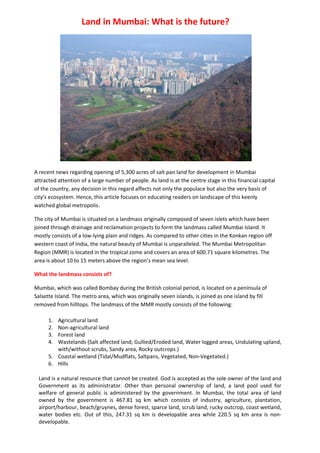Property81 land in mumbai what is the future
- 1. Land╠²in╠²Mumbai:╠²What╠²is╠²the╠²future?╠² ╠² A╠²recent╠²news╠²regarding╠²opening╠²of╠²5,300╠²acres╠²of╠²salt╠²pan╠²land╠²for╠²development╠²in╠²Mumbai╠² attracted╠²attention╠²of╠²a╠²large╠²number╠²of╠²people.╠²As╠²land╠²is╠²at╠²the╠²centre╠²stage╠²in╠²this╠²financial╠²capital╠² of╠²the╠²country,╠²any╠²decision╠²in╠²this╠²regard╠²affects╠²not╠²only╠²the╠²populace╠²but╠²also╠²the╠²very╠²basis╠²of╠² cityŌĆÖs╠²ecosystem.╠²Hence,╠²this╠²article╠²focuses╠²on╠²educating╠²readers╠²on╠²landscape╠²of╠²this╠²keenly╠² watched╠²global╠²metropolis.╠²╠² The╠²city╠²of╠²Mumbai╠²is╠²situated╠²on╠²a╠²landmass╠²originally╠²composed╠²of╠²seven╠²islets╠²which╠²have╠²been╠² joined╠²through╠²drainage╠²and╠²reclamation╠²projects╠²to╠²form╠²the╠²landmass╠²called╠²Mumbai╠²Island.╠²It╠² mostly╠²consists╠²of╠²a╠²lowŌĆÉlying╠²plain╠²and╠²ridges.╠²As╠²compared╠²to╠²other╠²cities╠²in╠²the╠²Konkan╠²region╠²off╠² western╠²coast╠²of╠²India,╠²the╠²natural╠²beauty╠²of╠²Mumbai╠²is╠²unparalleled.╠²The╠²Mumbai╠²Metropolitan╠² Region╠²(MMR)╠²is╠²located╠²in╠²the╠²tropical╠²zome╠²and╠²covers╠²an╠²area╠²of╠²600.71╠²square╠²kilometres.╠²The╠² area╠²is╠²about╠²10╠²to╠²15╠²meters╠²above╠²the╠²regionŌĆÖs╠²mean╠²sea╠²level.╠²╠² What╠²the╠²landmass╠²consists╠²of?╠² Mumbai,╠²which╠²was╠²called╠²Bombay╠²during╠²the╠²British╠²colonial╠²period,╠²is╠²located╠²on╠²a╠²peninsula╠²of╠² Salsette╠²Island.╠²The╠²metro╠²area,╠²which╠²was╠²originally╠²seven╠²islands,╠²is╠²joined╠²as╠²one╠²island╠²by╠²fill╠² removed╠²from╠²hilltops.╠²The╠²landmass╠²of╠²the╠²MMR╠²mostly╠²consists╠²of╠²the╠²following:╠²╠² 1. Agricultural╠²land╠² 2. NonŌĆÉagricultural╠²land╠² 3. Forest╠²land╠² 4. Wastelands╠²(Salt╠²affected╠²land;╠²Gullied/Eroded╠²land,╠²Water╠²logged╠²areas,╠²Undulating╠²upland,╠² with/without╠²scrubs,╠²Sandy╠²area,╠²Rocky╠²outcrops.)╠² 5. Coastal╠²wetland╠²(Tidal/Mudflats,╠²Saltpans,╠²Vegetated,╠²NonŌĆÉVegetated.)╠² 6. Hills╠² Land╠²is╠²a╠²natural╠²resource╠²that╠²cannot╠²be╠²created.╠²God╠²is╠²accepted╠²as╠²the╠²sole╠²owner╠²of╠²the╠²land╠²and╠² Government╠² as╠² its╠² administrator.╠² Other╠² than╠² personal╠² ownership╠² of╠² land,╠² a╠² land╠² pool╠² used╠² for╠² welfare╠² of╠² general╠² public╠² is╠² administered╠² by╠² the╠² government.╠² In╠² Mumbai,╠² the╠² total╠² area╠² of╠² land╠² owned╠² by╠² the╠² government╠² is╠² 467.81╠² sq╠² km╠² which╠² consists╠² of╠² industry,╠² agriculture,╠² plantation,╠² airport/harbour,╠²beach/gruynes,╠²dense╠²forest,╠²sparce╠²land,╠²scrub╠²land,╠²rucky╠²outcrop,╠²coast╠²wetland,╠² water╠² bodies╠² etc.╠² Out╠² of╠² this,╠² 247.31╠² sq╠² km╠² is╠² developable╠² area╠² while╠² 220.5╠² sq╠² km╠² area╠² is╠² nonŌĆÉ developable.╠²╠²
- 2. Where╠²from╠²required╠²land╠²parcel╠²come?╠² Day╠²after╠²day,╠²the╠²population╠²of╠²Mumbai╠²is╠²swelling╠²alarmingly.╠²All╠²those╠²shifting╠²to╠²this╠²mega╠²city╠² require╠²a╠²place╠²to╠²reside╠²and╠²the╠²city╠²has╠²already╠²exploited╠²beyond╠²its╠²available╠²land╠²space.╠²Then,╠² where╠²this╠²space╠²will╠²come╠²from?╠²How╠²is╠²it╠²possible?╠² Conversion╠²of╠²land╠²use╠²is╠²seen╠²as╠²the╠²answer╠²to╠²above╠²questions.╠²Here,╠²we╠²are╠²stating╠²the╠²procedure╠² for╠²conversion╠²of╠²use╠²of╠²land╠²from╠²one╠²purpose╠²to╠²another. If╠²an╠²occupant╠²of╠²land╠²(a)╠²which╠²is╠²held╠²for╠²the╠²purpose╠²of╠²agriculture,╠²wishes╠²to╠²use╠²it╠²for╠²a╠²nonŌĆÉ agricultural╠²purpose,╠²or╠²(b)╠²if╠²land╠²is╠²held╠²for╠²a╠²particular╠²nonŌĆÉagricultural╠²purpose,╠²wishes╠²to╠²use╠²it╠² for╠²another╠²nonŌĆÉagricultural╠²purpose,╠²or╠²(c)╠²desires╠²to╠²use╠²it╠²for╠²the╠²same╠²nonŌĆÉagricultural╠²purpose╠² for╠²which╠²it╠²is╠²assessed╠²but╠²in╠²relaxation╠²of╠²any╠²of╠²the╠²conditions╠²imposed╠²at╠²the╠²time╠²of╠²grant╠²of╠²land╠² or╠² permission╠² for╠² such╠² nonŌĆÉagricultural╠² purpose,╠² such╠² occupant╠² shall╠² apply╠² to╠² the╠² Collector╠² for╠² permission╠²in╠²accordance╠²with╠²the╠²form╠²prescribed.╠²╠² New╠²Development╠²Control╠²Rules╠²(DCR)╠² A╠²person╠²regularly╠²deals╠²with╠²real╠²estate╠²sector╠²directly╠²or╠²directly.╠²He╠²often╠²comes╠²across╠²concepts╠² such╠² as╠² Floor╠² Space╠² Index╠² (FSI)╠² and╠² Transferable╠² Development╠² Rights╠² (TDR).╠² These╠² concepts╠² are╠² explained╠²in╠²the╠²Development╠²Control╠²Regulations╠²for╠²Greater╠²Bombay,╠²1991.╠²These╠²Regulations╠²are╠² applicable╠²only╠²for╠²the╠²City╠²and╠²suburbs╠²of╠²Mumbai.╠² The╠²FSI╠²has╠²been╠²defined╠²to╠²mean╠²the╠²quotient╠²of╠²the╠²ratio╠²of╠²the╠²combined╠²gross╠²floor╠²area╠²of╠²all╠² floors╠²in╠²a╠²building╠²to╠²the╠²total╠²area╠²of╠²the╠²plot.╠²The╠²FSI╠²denotes╠²the╠²total╠²constructed╠²area╠²which╠²is╠² possible╠²on╠²a╠²given╠²plot╠²of╠²land.╠²For╠²instance,╠²if╠²the╠²area╠²of╠²a╠²plot╠²of╠²land╠²is╠²100╠²square╠²metres╠²and╠² the╠²prevailing╠²FSI╠²quotient╠²for╠²that╠²area╠²is╠²1.33,╠²then╠²the╠²total╠²possible╠²constructed╠²area╠²on╠²that╠²plot╠² would╠²be╠²1,330╠²square╠²metres.╠² The╠²FSI╠²is╠²the╠²most╠²important╠²component╠²of╠²real╠²estate╠²development╠²as╠²it╠²signifies╠²the╠²amount╠²of╠² construction╠²which╠²is╠²possible╠²on╠²a╠²given╠²plot╠²of╠²land.╠²Under╠²the╠²DCR,╠²different╠²FSI╠²quotients╠²have╠² been╠² specified╠² for╠² different╠² parts╠² of╠² Mumbai╠² divided╠² into╠² zones╠² such╠² as╠² residential,╠² commercial,╠² industrial,╠² educational╠² etc.╠² The╠² maximum╠² permissible╠² FSI╠² earmarked╠² for╠² some╠² of╠² the╠² areas╠² in╠² Mumbai╠²are╠²given╠²below.╠² ╠² Number╠² Area╠²and╠²type╠²of╠²occupancy╠² FSI╠²permissible╠² 1╠² Residential╠²and╠²Commercial╠²Zone╠² a) South╠²Mumbai╠²to╠²Mahim╠²╠² b) Suburbs╠² ╠² 1.33╠² 1.5╠² 2╠² Service╠²Industrial╠²Zone╠² ╠²╠²╠²╠²╠²╠²╠²╠²╠²╠²╠²╠²╠²╠²1.5╠² 3╠² Institutional╠²Buildings╠² a) South╠²Mumbai╠²to╠²Mahim╠² b) Suburbs╠² ╠² 1.33╠² 1.5╠² ╠² In╠²the╠²following╠²cases,╠²certain╠²additional╠²FSI╠²is╠²allowed:╠²╠² Road╠²widening╠²and╠²construction╠²of╠²new╠²roads:╠²BMC╠²would╠²allow╠²additional╠²FSI╠²on╠²100%╠²of╠²the╠²area╠² required╠² for╠² the╠² roads╠² if╠² the╠² owner╠² of╠² the╠² land╠² surrenders╠² it╠² free╠² of╠² compensation╠² to╠² the╠² BMC.╠²╠² ╠² Institutional╠²Buildings:╠²BMC╠²may╠²permit╠²additional╠²FSI╠²for╠²such╠²buildings╠²subject╠²to╠²the╠²terms╠²and╠² conditions╠²specified╠²by╠²the╠²BMC╠²in╠²this╠²regard.╠² Hotels:╠²FSI╠²can╠²be╠²exceeded╠²by╠²starred╠²category╠²of╠²residential╠²hotels╠²in╠²accordance╠²with╠²the╠²terms╠² and╠²conditions╠²specified╠²by╠²the╠²BMC╠²in╠²this╠²regard.╠²
- 3. MHADA╠²Schemes:╠²LowŌĆÉcost╠²housing╠²schemes,╠²for╠²the╠²economically╠²weaker╠²sections╠²of╠²the╠²society,╠² developed╠² by╠² the╠² Maharashtra╠² Housing╠² and╠² Area╠² Development╠² Authority╠² are╠² also╠² eligible╠² for╠² additional╠²FSI╠²over╠²and╠²above╠²those╠²specified╠²in╠²the╠²table.╠² Cessed╠² Buildings:╠² For╠² the╠² reconstruction╠² of╠² cessed╠² buildings╠² located╠² in╠² the╠² Island╠² City,╠² the╠² FSI╠² available╠²is╠²as╠²high╠²as╠²2.5╠²on╠²the╠²gross╠²plot╠²area.╠²A╠²cessed╠²building╠²means╠²a╠²heritage╠²building,╠²etc.╠² Similarly╠²for╠²repairs╠²of╠²cessed╠²buildings╠²and╠²Urban╠²Renewal╠²Schemes╠²undertaken╠²by╠²MHADA╠²the╠²FSI╠² shall╠²extend╠²upto╠²the╠²area╠²required╠²for╠²rehabilitation╠²of╠²the╠²occupiers.╠² Slum╠²redevelopment╠²scheme:╠²For╠²redevelopment╠²of╠²slums,╠²pavements,╠²construction╠²of╠²transit╠²camp╠² tenements,╠²etc.╠²additional╠²FSI╠²is╠²allowed╠²subject╠²to╠²the╠²terms╠²and╠²conditions╠²specified╠²in╠²this╠²regard.╠² ╠² Software╠²Buildings:╠²BMC╠²may╠²permit╠²the╠²maximum╠²permissible╠²FSI╠²to╠²be╠²exceeded╠²by╠²buildings╠²on╠² plots╠² of╠² Information╠² Technology╠² establishments╠² set╠² up╠² by╠² Public╠² Bodies╠² such╠² as╠² MHADA,╠² SEEPZ,╠² SICOM,╠²etc.╠²or╠²their╠²joint╠²ventures.╠² ╠² Future╠²of╠²land╠²and╠²GovtŌĆÖs╠²planning╠² In╠²its╠²final╠²draft╠²of╠²New╠²Housing╠²Policy╠²and╠²Action╠²Plan,╠²2015,╠²the╠²Government╠²of╠²Maharashtra╠²points╠² out╠²that╠²key╠²factor╠²affecting╠²housing╠²is╠²cost╠²of╠²land.╠²The╠²key╠²to╠²reducing╠²cost╠²is╠²supply╠²of╠²land╠²with╠² Government╠²being╠²a╠²catalyst╠²in╠²the╠²process.╠²The╠²Government╠²will╠²introduce╠²land╠²supply╠²periodically╠² by╠²putting╠²in╠²place╠²the╠²necessary╠²regulatory╠²framework╠²to╠²encourage╠²supply╠²from╠²the╠²private╠²sector.╠² It╠²is╠²necessary╠²that╠²government╠²land╠²as╠²well╠²as╠²the╠²lands╠²at╠²the╠²disposal╠²of╠²State╠²Government╠²entities╠² such╠²as╠²MIDC,╠²Mahasagar╠²Dairy,╠²ULBs,╠²CIDCO,╠²MHADA╠²and╠²MMRDA╠²are╠²pooled╠²together╠²and╠²used╠² for╠²housing,╠²states╠²the╠²draft.╠²╠² The╠²land╠²owner╠²i.e.╠²State╠²Government╠²or╠²its╠²entities╠²will╠²be╠²compensated╠²at╠²the╠²Ready╠²Reckoner╠² Rate╠²for╠²use╠²of╠²their╠²land╠²to╠²provide╠²affordable╠²housing.╠²The╠²government╠²land╠²bank╠²will╠²include╠²all╠² land╠²available╠²with╠²MHADA,╠²MCGM╠²and╠²MMRDA╠²in╠²the╠²city╠²of╠²Mumbai╠²and╠²in╠²the╠²other╠²cities╠²of╠²the╠² State,╠²the╠²surplus╠²lands╠²with╠²various╠²State╠²Government╠²departments,╠²textile╠²mill╠²lands╠²in╠²the╠²share╠² of╠²MHADA,╠²unused╠²MIDC╠²lands,╠²MIDC╠²lands╠²where╠²the╠²industries╠²are╠²defunct╠²and╠²which╠²can╠²be╠²used╠² for╠²housing╠²etc.╠²Preparation╠²of╠²the╠²government╠²land╠²bank╠²plan╠²will╠²ensure╠²efficient╠²land╠²use.╠²All╠²such╠² surplus╠² land╠² will╠² be╠² beneficially╠² used╠² for╠² housing,╠² especially╠² affordable╠² housing,╠² the╠² draft╠² further╠² adds.╠²╠² The╠²draft╠²makes╠²it╠²clear╠²that╠²if╠²the╠²lands╠²in╠²the╠²Government╠²Land╠²Bank╠²are╠²reserved╠²for╠²any╠²purpose,╠² all╠²such╠²reservations╠²shall╠²stand╠²deleted╠²and╠²the╠²lands╠²will╠²be╠²made╠²available╠²for╠²affordable╠²housing╠² unless╠²the╠²same╠²is╠²environmentally╠²not╠²feasible.╠² ╠²




































